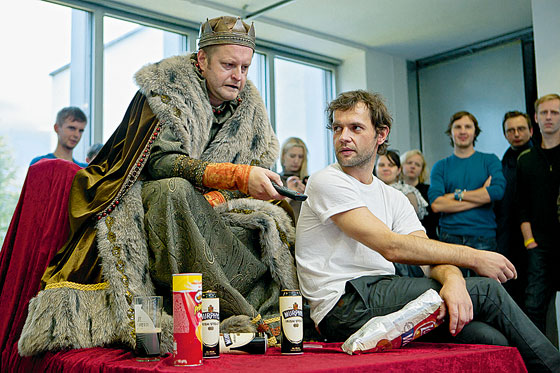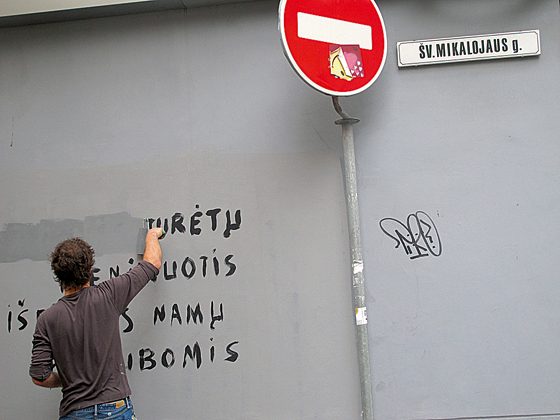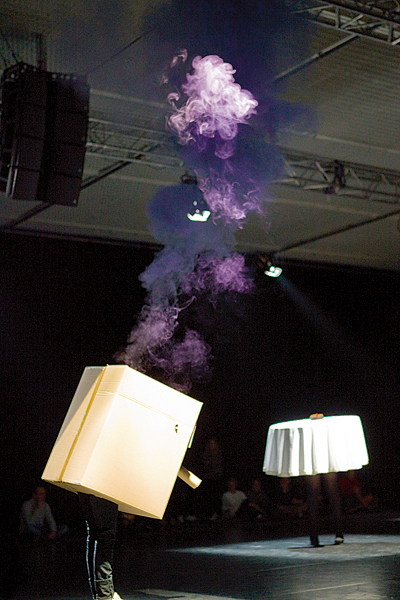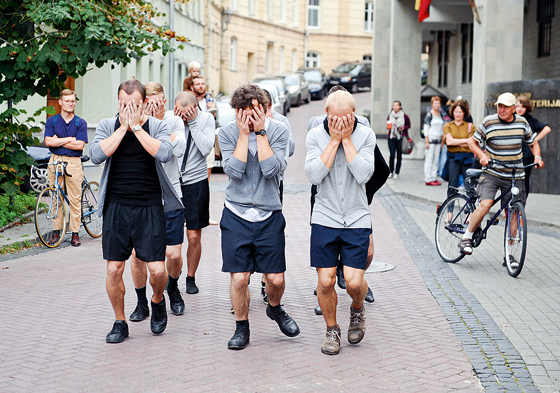|
|
| Ways to perform Eglė Juocevičiūtė, Art Critic, Curator An interview with the curators of the Mindaugas Triennial Mindaugas Triennial. 24.08.–09.09.2012. Contemporary Art Centre, Vilnius | |
| The 11th edition of the Baltic Triennial of International Art at the Contemporary Art Centre in Vilnius was a 12 day event focussed exclusively on performance and film. The triennial was commissioned to four curators with different but equally great knowledge: the director of Witte de With Centre of Contemporary Art in Rotterdam, Defne Ayas; the director of the LUX organization in London, Benjamin Cook; and New York-based artists and curators Michael Portnoy and Ieva Misevičiūtė, who have worked together and curated performance events before. The starting point for the curators was the idea to counter the general tendency of biennials to be pluralist, all-encompassing multi-platforms. They went completely opposite and chose to channel the contributions of artists through a radically minimized vessel – one human being. The triennial was titled after its medium, who in his own right carries one of the most common Lithuanian names, Mindaugas. In Lithuanian Mindaugas can be interpreted as daug menąs – much wisdom, daugiamintis – the one who has many ideas, or daugio minimas – much fame. | |
 Rimas Šapauskas. Kingdom. View from the performance. 2012 Photo: Robertas Narkus Courtesy: CAC, Vilnius | |
| This interview with three of the curators – Benjamin, Ieva and Michael – took place after the first weekend of the triennial, and shows a bit of how it all came together; it explains a clash of thinking methodologies and corrects some wrong conclusions. Eglė Juocevičiūtė: As I already had read in your earlier interview, it was the idea of Kęstutis Kuizinas, the director of CAC, to make this triennial a performance and cinema festival, rather than a big and long visual art exhibition. So you had a given form. In this interview Defne said that the search for content began by exploring Vilnius and Lithuania, looking for localities and site-specificity. How can we see that in the triennial, apart from Mindaugas’ name and its connotations for Lithuanian-speaking people? Benjamin Cook: I guess it was very much about trying to site it here in a very live way, to use Vilnius as the raw materials for this triennial, rather than just come here and respond to it in a kind of naive way. To actually use the raw materials of the city, the people here and the very logistics of staging something here, to get really involved with the place as a site. Ieva Misevičiūtė: Even if you asked to put Mindaugas aside, I would like to bring him back, because he is not only “the space” for a triennial but also our “channel” through which we connect to the city. It‘s not only a human body, but it’s also Vilnius seen through the eyes of Mindaugas. Invited artists had to understand that their works had to be channeled through and understood through a man who is an image of common Lithuanian knowledge. We chose an entirely different point of departure or a lens through which we accessed the local goings-on much more through the personal, rather than something that would involve city stories or contexts. B.C.: I think the thing that’s important about Mindaugas is what personal set of references everybody brings to that name. It was interesting talking about that name to people during the research period. Instantly, everybody knows some Mindaugas, and that makes everything become personal. Even at the opening ceremony, the Minister of Culture was talking about his brother named Mindaugas. That gives access to the triennial in a personal way, in a meaningful and subjective way at the same time. I.M.: Exactly. We wanted to counter this attitude of big international art events that land like umbrellas, and suddenly they start reflecting upon the local via collecting the context into their content. We took the opposite approach – to zoom into the very subjective, and to present the artistic works through that. Michael Portnoy: Although the engagement of all the local realities is inevitable while using the sites that we chose, but in a less overt, didactic manner. For instance, with Adam Kleinman’s activation of Mindaugas, Mindaugas stares at a potato at various local sites which contain skeletons in their closets, so to speak. I.M.: Yes, absolutely, the context in which Mindaugas is chosen to be enacted, the locations for particular works automatically engage all the social, political and cultural environments. E.J.: That’s interesting to hear, because before talking to you I had a vision of Mindaugas only as a broadcaster from the artist to us, the viewers, but not as a broadcaster from us to the artists. I.M.: Yes, a broadcaster, but also a messenger. Every space, even if it is a white cube, carries a certain field of information. And in this case Mindaugas is like a container of local images which is empty enough to be a vessel. E.J.: So all the invited artists had to get to know Mindaugas very well, to talk to him for hours? M.P.: Not necessarily, some of them had a very close relationship, and ideas went through the development process, and others sent us a series of instructions, scenarios that Mindaugas would have to realize. | |
 Tim Etchells. Ways forward. View from the performance. 2012 Publicity photos Courtesy of the artist | |
| I.M.: Some slept with him in a same room, or, like Marianne Vitale, took a road trip for a couple of days. E.J.: I really liked the advertising campaign you did for the triennial, one could see Mindaugas looking out from posters all over the city and on TV, I don’t know when was the last time I saw an advertisement for CAC events on TV… And the message of the poster, as I understand, is “I’m a simple guy, just one of you, don’t be afraid and come to meet me at CAC, everybody”. But after attending the performances of the first weekend, I had the feeling that it didn’t really work out to attract a very wide public, in some way maybe it’s due to the performance genre as a temporal art form which can be watched by a limited amount of people. It seemed more like a nice and cosy community of triennial viewers, were you expecting something else? I.M.: No. Don’t you think that there were at least 300 people at each of the evening events? I wouldn’t call it small, it was an overload of people! M.P.: We heard from people at the CAC that it turned out that there were far more viewers than they expected. I.M.: And for the performance on Sunday morning at 7.30(1), to have more than 30 people coming – that’s quite good. Or during Tim Etchell’s performance(2): Mindaugas was followed by ten to twenty people at all times. M.P.: And with hundreds of people passing by. I was actually walking by while the statements were still up, and saw a bunch of kids who were standing and staring at the statements, talking about them to each other. I. M.: It’s just the first weekend, and we have two more weeks to go with a lot of different events. B.C.: I think things will happen in a different kind of tone, in a different concentration, it will provide diverse experiences. Everything is not going to be a mass experience, some events can be more like coming together. M.P.: Our advertising campaign may seem populist, but it’s very tongue-in-cheek, and using the mass media framing as a weird, satirical lure to a collection of events, many of which are decidedly non-populist in nature. But it was funny, Mindaugas’ “real-life” friends were joking with him that when Lady Gaga came to town, she would be very pissed that his face was on more the walls than hers! I.M.: And I wouldn‘t say that performances are attended less than any other medium of art – cinema or the visual arts. I think contemporary art in general is not a populist thing, in the sense of attracting thousands of people. In fact, I think that performance and cinema definitely have this ability to nail the attention of the audience for a fixed amount of time. And both of these mediums deal directly with showmanship, which comes from directing and engaging the audience’s attention. In comparison, a visual art exhibition exists in a passive engagement way, where the viewer is free to enter and exit, and enter again. In cinema and performance this would not work, one has to commit to spend a fixed amount of time in order to access the piece. E.J.: And that is very good! And I see exactly what you mean, it reminds me of people I talked to at the opening night saying: “It’s so nice to watch an exhibition with so many people at the same time”. What I got myself to think about during the opening night was this idea of charisma research. As a visual art viewer, I am used to paying little attention to the fact whether the artist is charismatic or not, the most important is that the form and concept of an artwork should be appealing. And while watching these evening performances in the Charismateria Hall at the CAC I realized what a significant impact charisma has for me: as far as a script is often chaotic and hard to follow, I can either get bored to death or I can get fascinated by every movement of the performer. As Ivo Dimchev’s performance started with the words “Enjoy the waste” – it depends so much on charisma whether you feel like wasting your time and attention or not. I had never seen this so clearly before. How did you come up with the idea to deal with charisma in contemporary art spaces? M.P.: In some way it was meant to counter the tendency in contemporary art of antitheatricality. And to propose the idea that entertainment, charisma and stagecraft can also be platforms for critique… I.M.: …and also to propose that theatricality does not occupy one’s mind only with the visual, leaving no space for thinking or contemplating. These spaces created by artistic charisma are also spaces for contemplation. But also I think the concept of “Charismateria” ties in all three parts of the triennial programme. I would like to explain this by talking about two methods that we dealt with when we started this project. As you said, there’s this visual art viewer attitude, paying almost no attention to charisma of the artist. And there’s also visual art performance, which is mainly based on the concept, and the execution of it is later chosen to be live. Whereas contemporary theatre performance starts with the body and with the charisma of the performer, and the concept comes second to tie in the bodily expression. And in that sense, the programme is very much built like that. For the first half of the day we have, I would say, more concept-driven performances, whereas the evening programme presents charisma as the prime material for a creation. The “Cinema of the Self” really deals with the understanding of the self, how the construction of the identity and the self could also be expanded into the medium. | |
 Miet Warlop. Tragic Heroes. View from the performance. 2012 Photo: Linas Vasiljauskas Publicity photo Courtesy of CAC, Vilnius | |
| E.J.: I’ve only managed to see two and a half films so far, that’s only one third of the “Cinema of the Self” programme, but watching and reading the synopsis I was trying to find out the criteria for picking out exactly these films. Was it the diversity of socio-geopolitical identities? B.C.: Unlike performance, films have to already exist, so they can’t respond so easily to the context of a situation. So in terms of the criteria, I think every film has something to say about construction of the self, expression of self or positioning of self. If you’ve seen a couple of things you might have noticed that they deal with quite wide subjects or areas, and they are quite different tonally as well. I was not interested in creating a flat didactic programme, advancing a thesis where, by the end of the day, I would make my point, but rather to propose a starting position through which the audience could approach it. E.J.: Just before meeting you I watched Eric Baudelaire‘s The Anabasis of May and Fusako Shigenobu, Masao Adachi and 27 Years Without Images (68 min, 2011), which was completely about performing identity. B.C.: Yes, exactly, in this particular film there are these two key things: the issue of self-expression in a political sense, and the issue of representing or not representing the self. I’m more interested in proposing this film in a more humanist, empathetic way, rather than saying “I’m doing a programme about the Japanese Red Army”. There’s a big story behind each film, and a big frame of reference. One of the things that I have a problem with in terms of artists’ films is this kind of overdetermined relational programming, where it‘s always very strictly about a thesis or circulating some particular aesthetic, which I think is tiring for the audience. That’s why I simply propose a number of different films that are ordered in a certain way. E.J.: Every film day the programme is supposed to end with a new series of the Mark Aerial Waller film Time Together. Are they already finished or are they being created just now? B.C.: Mark is creating the series on a daily basis. He’s writing and shooting on a daily basis, responding to Mindaugas’ actions. He has the idea of a narrative, of where he’s going with it, but he’s trying to be as open as possible, and this is really stressful for everybody... So basically he writes it, they shoot it, edit it and show it at 8 pm everyday. M.P.: It was our idea to commission a film that would serve us as a documentary, but we wanted to avoid flat documentation in favour of something more personal and oblique. B.C.: And also, as the performances are of Vilnius and many local people are drawn into the production, so the series are very much a production of the triennial itself. There are also other keys and connections to the locality, like the lady actress, the star of a local soap opera. M.P.: This helps to complicate the things that have occurred, and to add more layers of fiction to the activations of Mindaugas. E.J.: This triennial is the first such a major event concerning performance in Lithuania, and it‘s quite a new field for me also. As you have been involved in it for some time already, do you see some changes or a direction of development of artistic performativity research, is it somehow different now than it was in the mid- 90s, for example? I.M.: I think it‘s like Michael mentioned: the word “theatricality” is not as dirty a word as it used to be. People both in visual arts as well as in the performing arts dare to get into that. For example, Alexandra Bachzetsis in her performance A Piece Danced Alone flirts with the audience. She makes the dance very personal, but she actually displaces that focus of the personal towards the very much communitary, approaching the audience directly with her gaze. Or another example: Ivo Dimchev, who takes theatricality to its extreme. Instead of fearing to engage with it or stripping down his performance to quite minimal means, he accelerates it, to where theatricality almost feeds back on itself . | |
 Eglė Budvytytė. A Choreography for the Running Male. View from the performance. 2012 Photo: Ieva Budzeikaitė Publicity photo Courtesy of CAC, Vilnius | |
| M.P.: This avoidance of theatricality in contemporary dance and theatre comes from a reaction against the expressionist trends of dance in the 1980s and 1990s, which were overemotional. For a while we’ve been in this almost degree-zero territory with dance and theatre. And I think people are finally breaking out of the fear and, as Ieva says, finding new forms of theatricality. I.M.: I think that more and more visual artists choose live the embodiment of their work as a medium that appeals maybe a little bit faster, or works as searches for conveying ideas. It’s hard to summarize so quickly. But it’s what we are aiming to do with our triennial – to present these two very different but equally interesting forms of making performance: one starting with the concept and finding its embodiment, and the other one starting from the body. M.P.: Rarely do these two modes appear in the same venue. It’s very important for us to expose the visual arts audience to these other methodologies. I.M.: Not only do these two modes not appear together, but very often they are entirely misunderstood. One is completely dismissed for its overtheatrical expression, the other is dismissed for its lack of stagecraft. That’s why often visual artists do not present their work in a theatre, though they do make performances. That’s entirely another method and another market. And having these two forms of performance really opens certain spaces within its making, certain spaces of exchange, that could really feed into each other. E.J.: Mindaugas started Oblivio by saying that the artist wanted him to start one way, but he feels like starting the other way. That made me think of how autonomous Mindaugas and the performers in “Charismateria” events are? M.P.: The performances in “Charismateria” are very well rehearsed, for the most part they have been developed for months, and in some cases several years while touring. But it’s a good question about how autonomous Mindaugas is. The only limitations are his personal limitations of what he wouldn’t do. But so far, he’s been extremely adventurous and willing to take on all of these scenarios, instructions and roles. But there’s always this inevitable friction between what was imposed upon him and what is he willing to do. I would have found it a little sad if the person of the actor playing Mindaugas had not shown out sometimes. E.J.: So is who person playing Mindaugas? How did you find this charismatic man that everybody falls more and more in love with while creating their own Mindaugas in their mind? I.M.: Well, we had a quite long process of auditions, and there were quite a few aspects of his abilities that we required. Most of all we looked for his flexibility. And also enthusiasm and interest, as well as open-mindedness and understanding of this process. So from all the different options that we had, Darius Gumauskas seemed as the most flexible and versatile to really embody so many different Mindaugases. He has no fixed character in the theatre, he has played dramatic heroes as well as lovers, that was important to us. He’s also one of those few that refuse to act on TV, to do commercials and soap operas – that’s another thing that we didn’t want: to have a widely known face. So he was perfect to empty himself as much as possible. So far, he’s really willing and enthusiastic , and commits to each and every project. E.J.: I think you really got lucky to find such open-minded actor in Lithuania, from what I know of our actor training system and their theatre-mindedness. I.M.: Exactly, and someone who would be interested to step into a conceptually very different environment. It’s very important to understand to be able to enact it. E.J.: Well, so far I have enjoyed the triennial and Mindaugas very much, and I think it’s a great clash of two different worlds. Thank you for your time and good luck for the rest of the triennial! (1) Aslı Çavuşoğlu performance Incubatio in the Jeruzalė sculpture garden on the outskirts of Vilnius, where Mindaugas related what he was dreaming at night and his dreams were analyzed by an anthropologist. (2) In Tim Etchell‘s performance Ways Forward Mindaugas was painting and repainting imperative statements and proposals on the walls in Vilnius old town for 8 hours. | |
| go back | |







